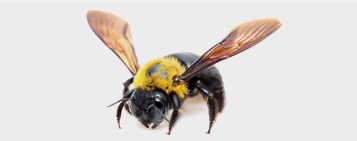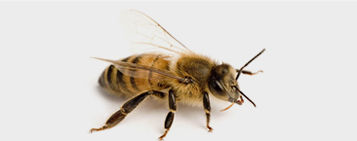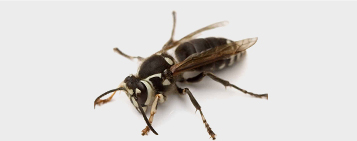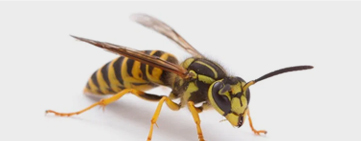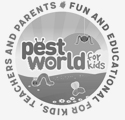INfomation about
Bees & Wasps
A small
Intro about Bees
Bees can be difficult for residential and commercial properties to control in NYC & NJ. Having a professional pest control company that specializes in serving New York and New Jersey is essential to a long term bees control solution that provides peace of mind.
Carpenter Bees
Xylocopa spp.
Overview:
Carpenter bees get their common name from their habit of boring into wood to make galleries for rearing their young. Carpenter bees resemble bumblebees but their abdomen is largely bare and shiny.
Habits:
Carpenter bees are not social insects and do not live in nests or colonies. The adults over-winter, typically in abandoned nest tunnels. In the spring, they emerge and feed on nectar. To excavate galleries, female carpenter bees bore circular holes the same diameter as their bodies straight into wood, and then turn to tunnel along the grain of the wood.
Threats:
Carpenter bees are a serious property threat, and can cause structural damage over time if left untreated. They prefer weathered and unpainted wood. Male carpenter bees can be territorial and may hover in front of one’s face
aggressively, but they have no stinger and these actions are merely for show. Female carpenter bees do have a potent sting, but it is rarely used.
Prevention:
- Carpenter bees prefer bare wood, so painting and staining wood can sometimes deter them.
- Routinely inspect wood on your property for signs of a carpenter bee infestation, including round, smooth holes
- In some cases, carpenter bees will attack stained or painted wood. If you suspect a carpenter bee infestation, contact a licensed pest professional.
Did you know? Carpenter bees…
- will chew a tunnel into a piece of wood to build a nest gallery. The bits of wood they chew and deposit outside the nest are called frass.
- stingers are not barbed, so the female can sting over and over again.
- tunnel openings usually look about one or two inches deep, but they can be up to 10 feet long.
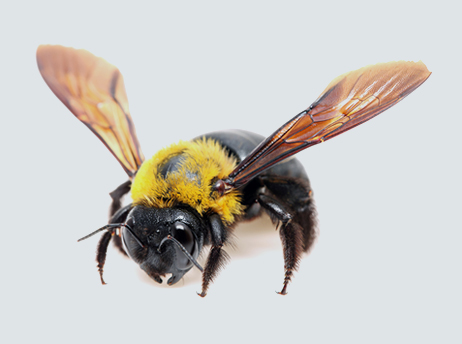

Color:
Yellow and black
Shape:
Robust, oval
Size:
¹⁄2 – 1 inch long
Region:
Found throughout the U.S.Packages For Bees Protection
Save Money Today
up to $75 OFF
If you are a new customer, enjoy $75.00 off your Home Pest Protection Premium plan.
Coupon Code: HomePre22

Call & Get Your Free Estimate
855-737-8765
Africanized “Killer” Bees
Apis mellifera scutellata
Overview:
Africanized “killer” bees look so much like regular honeybees that the only way to tell the two apart is by measuring their bodies. A dangerous stinging insect, Africanized bees have different wing measurements than honeybees.
Habits:
Africanized bees have small colonies, so they can build nests in unique places. They have been known to live in tires, crates, boxes and empty cars. Worker bees gather both pollen and nectar from flowers to feed to the larvae and other members of the colony.
Threats:
These bees defend their colony and attack when threatened. Africanized bee venom is no more dangerous than regular honeybees. However, these bees tend to attack in greater numbers, which poses a significantly greater danger to humans, especially those who are allergic to bee stings.
Prevention:
- If you are chased by Africanized bees, run in a zigzag pattern and seek shelter in a house or car. Do not jump in water. The bees will just wait around for you to come up for air.
- Use caution when handling items on your property that could house an Africanized bee nest. Inspect items carefully for signs of infestation before moving or otherwise disturbing.
- Because of the aggressive nature of these pests and the enormity of their nests, a pest control professional or beekeeper must address an Africanized bee infestation.
Did you know? Africanized "killer" bees…
- have been known to chase people for over a quarter of a mile once they get excited and aggressive.
- can only sting once because their stingers are barbed and tear off when they try to get away.
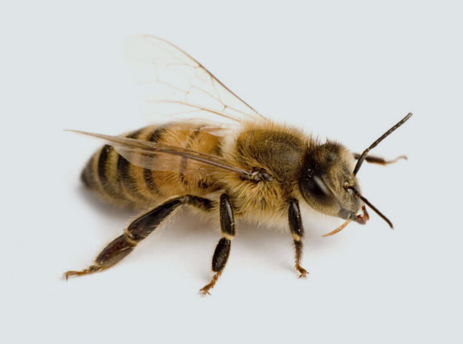

Color:
Golden-yellow with darker bands of brown
Shape:
Oval
Size:
¹⁄2 inch long
Region:
Found in Arizona, California, Florida, Texas, Nevada, New Mexico and OklahomaCall & Get Your Free Estimate
855-737-8765 or
Bald-Faced Hornets
Dolichovespula maculata
Overview:
This large black-and-white relative of the yellowjacket gets its common name from its largely black color but mostly white face. It is named a hornet because of its large size and aerial nest.
Habits:
Bald-faced hornets are social insects, although not true hornets. They live in colonies that may contain between 100 and 400 members at their peak. They usually appear in late summer when populations are largest. Bald-faced hornets build paper nests at least three or more feet off of the ground, usually in trees, shrubs, on overhangs, utility poles, houses, sheds or other structures.
Threats:
Bald-faced hornets are aggressive and will attack anyone or anything that invades their space. This makes bald-faced hornet removal somewhat difficult. They have smooth stingers, so they can sting over and over again. Their stings also carry venom that makes the stings hurt, itch or swell for about 24 hours. Humans are at the same risk of allergic reactions from a bald-faced hornet stings as with other insect stings
Prevention:
- Bald-faced hornets are beneficial insects that help to control many pest species. However, if a nest is close to the ground or near an occupied structure, control is warranted.
- Routinely inspect the outside of your home and any outbuildings for stinging insect nests.
- If you find a bald-faced hornet nest on your home or property, do not attempt to remove it on your own as this can aggravate the colony and cause them to attack. Contact a licensed pest management professional about hornet removal to avoid the risk of getting stung
Did you know? Bald-faced hornets…
- live in nests with as many as 400 workers
- do not reuse their nests season after season, as some stinging insects do.
- can build nests as large as 14 inches in diameter and more than 24 inches in length.
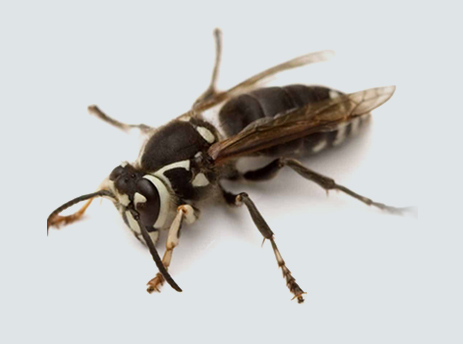

Color:
Black with white pattern on face
Shape:
Long, wasp-like
Size:
¹⁄2 – 5⁄₈ inches long; queen 3⁄₄ inches long
Region:
Found throughout the U.S.Call & Get Your Free Estimate
855-737-8765 or
Yellowjackets
Vespula spp.
Overview:
There are several species of yellowjackets. These flying insects typically have a yellow and black head/face and patterned abdomen. Many say that the pattern resembles stripes. The abdomen pattern can help an entomologist or pest professional identify specific types of yellowjackets.
Habits:
Yellowjackets are social insects that live in nests or colonies. They usually nest in the ground or in cavernous areas such as eaves and attics. Yellowjackets can be found anywhere humans can be found. They feed on sweets and proteins and are commonly attracted to trash and recycling bins. Yellowjackets are most active in the late summer and early autumn when a colony is at its peak.
Threats:
Yellowjackets’ stings pose significant health threats to humans. They are territorial and will sting if their nest is threatened. Yellowjackets may sting repeatedly and can cause allergic reactions.
Prevention:
- Wear shoes, especially in grassy areas.
- Remove garbage frequently and keep trashcans covered.
- Do not swat at a yellowjacket, as it increases the likelihood of an aggressive reaction.
- Avoid wearing sweet-smelling perfumes.
- Ensure all doors and windows in your home have screens that are in good condition.
- Seek immediate medical attention if stung, as reactions can be severe.
- If you find a yellowjacket nest on your home or in your property, contact a licensed pest professional.
Did you know? Yellowjackets…
- and other stinging insects send more than 500,000 people to the emergency room each year.
- live in colonies with up to 4,000 workers.
- build paper carton nests out of chewed up cellulose.
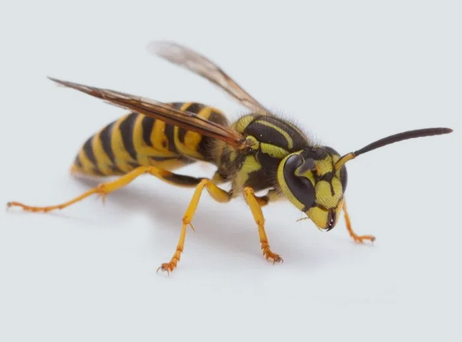

Color:
Abdomen usually black and yellow patterned similar to bands
Shape:
Wasp-like
Size:
3⁄₈ – 5⁄₈ inch long


